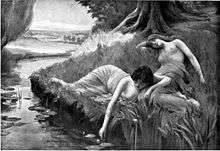Myling
In Scandinavian folklore, the mylingar were the phantasmal incarnations of the souls of children that had been forced to roam the earth until they could persuade someone (or otherwise cause enough of a ruckus to make their wishes known) to bury them properly.
Lore
The myling comes into existence when a child is unwanted and therefore killed by its mother. It can be heard singing in the night, thereby revealing the mother's crime.
Ways to help the myling is to give it a name or to find the corpse and bury it in holy soil. The myling (also known as "utburd" in Norwegian or "ihtiriekko" in Finnish) is said to chase lone wanderers at night and jump on their backs, demanding to be carried to the graveyard so they can rest in hallowed ground. Mylings are thought to be enormous and apparently grow heavier as they near the graveyard, to the point where any person carrying one (or more) could sink into the soil. If one should prove unable to make it into the cemetery, the myling kills its victim in a rage.
History
The word "utburd" means "that which is taken outside" and refers to the practice of abandoning unwanted children (e.g., children born out of wedlock or to parents who lacked the means to care for them) in the woods or in other remote places where death is almost certain to befall them. It is believed that the ghost of the child will then haunt the place where they had died or, as told of in countless stories, the dwellings of their killers.
This infanticide was generally carried out secretly and its victims were often abandoned shortly after birth. From the perspective of certain Christian denominations, the babies were thus denied baptism, acceptance into the Church, and proper burial. As such, they could not rest peacefully.
The belief that mylings are enraged and seeking revenge is what gave them the reputation as one of the most menacing types of ghosts in Scandinavian folklore.
See also
- Bukavac
- Drekavac
- Konaki-jiji (Japanese "Myling")
- Poroniec
- Wiedergänger
References
Sources
- af Klintberg, Bengt (2010). "Death and the Dead". The Types of the Swedish Folk Legend. Helsinki: Academia Scientiarum Fennica. pp. 81–85. ISBN 9789514110535. SELIBR 12098688.
- Kvideland, Reimund; Sehmsdorf, Henning K. (1988). Scandinavian Folk Belief and Legend. The Nordic Series. 14. Oslo: Norwegian University Press. pp. 113–118. ISBN 978-82-00-02638-9. SELIBR 7166116.
- Pentikäinen, Juha (1989). Simpson, Elizabeth; Sehmsdorf, Henning K.; Kvideland, Reimund (eds.). Nordic folklore: recent studies. Folklore studies in translation, 99-0588351-7. Bloomington, Ind.: Indiana Univ. press. pp. 128–136. ISBN 978-0-253-33125-0. SELIBR 4733374.
- Pentikäinen, Juha (1968). The Nordic dead-child tradition: Nordic dead-child beings : a study in comparative religion. FF communications, 0014-5815 ; 202. Helsinki. SELIBR 8151831.
- Simpson, Jacqueline, ed. (1988). Scandinavian folktales. Penguin folklore library. London: Penguin. ISBN 978-0-14-059505-5. SELIBR 4581479.
